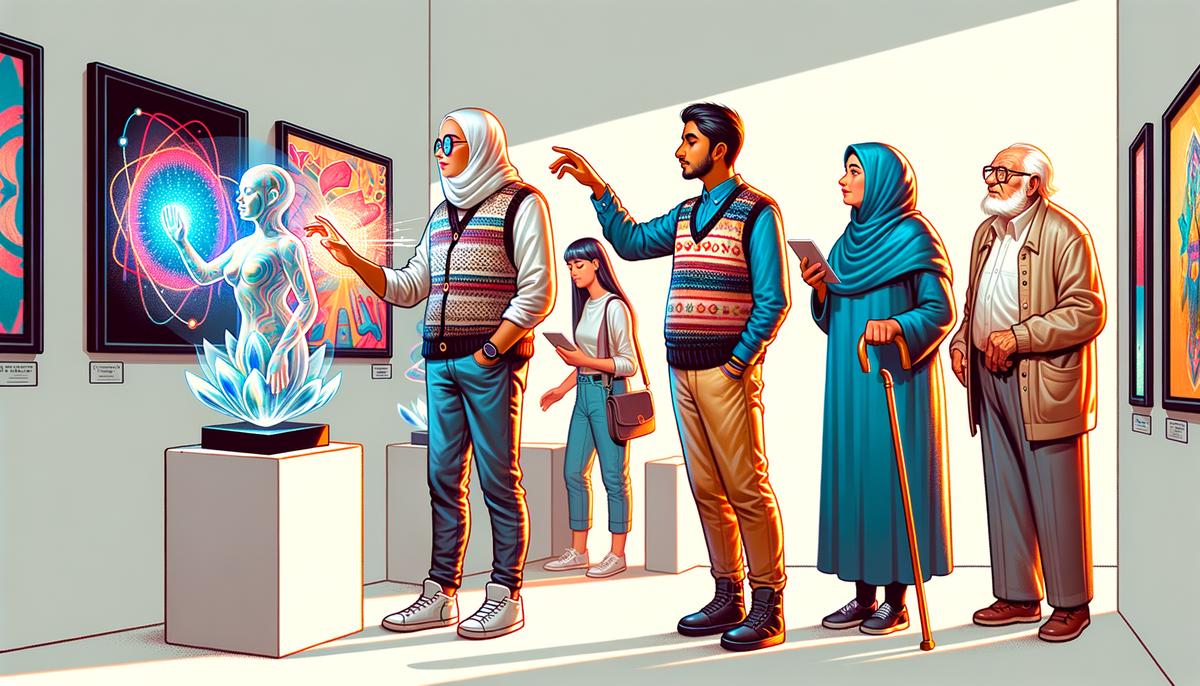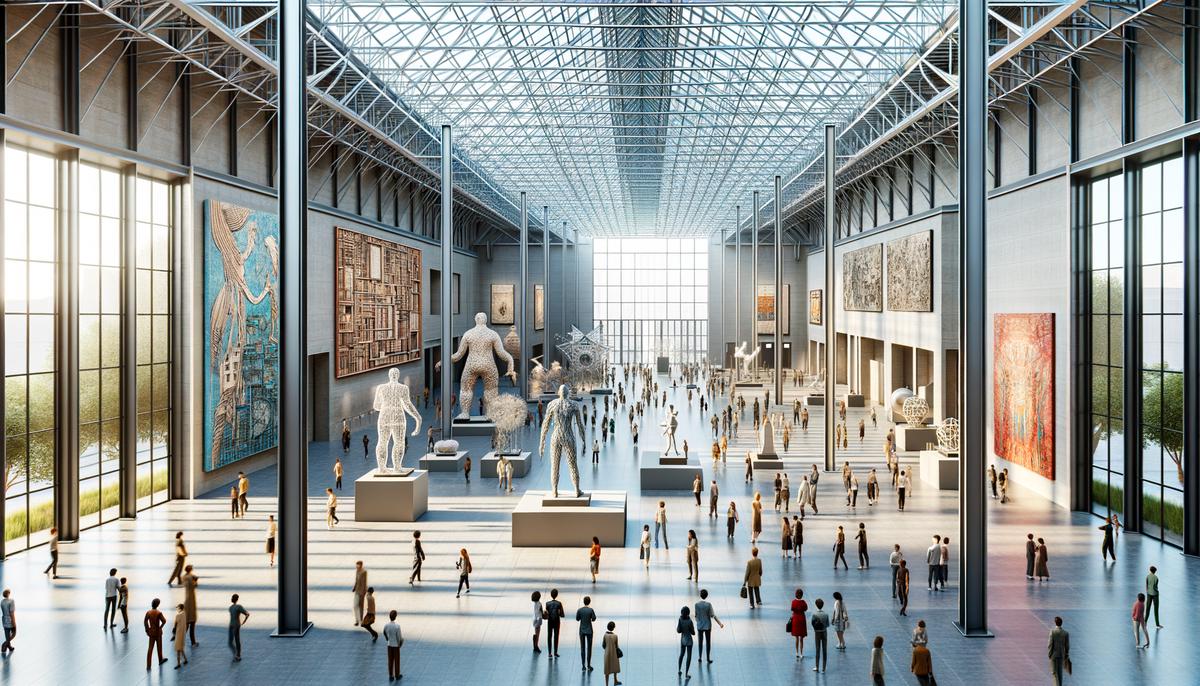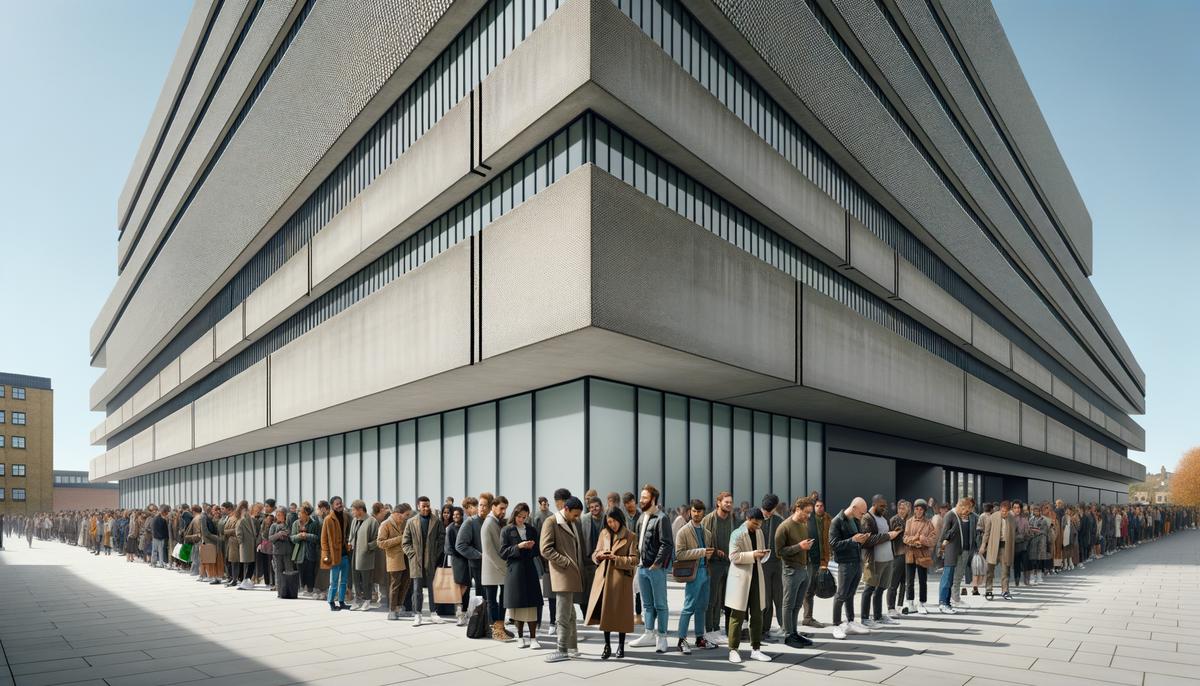The Tate Modern in London is more than just a gallery; it’s a groundbreaking space that reshapes our understanding and interaction with art. Through its innovative curation, thematic exhibitions, and embrace of interactive elements, it challenges us to see and experience art in new ways. As we explore its diverse and inclusive displays, we find ourselves partaking in a broader dialogue about what art is, who it’s for, and the role it plays in society today.
Curation and Themes
Tate Modern, nestled in the heart of London, stands not just as a home for contemporary and modern art but as a pioneer in curatorial innovation. As we wander through its expansive halls, it’s clear that the gallery’s unique approach to displaying art does more than showcase work; it shapes our very experience and understanding of art in profound ways.
At the core of Tate Modern’s philosophy is the idea of thematic rather than chronological exhibitions. Instead of walking through time, visitors navigate through concepts, themes, or ideas that transcend specific periods or movements. This method challenges us to draw connections between different eras and artists, encouraging a deeper engagement with the artwork.
Take, for instance, the Materials and Objects display. Here, works from vastly different contexts and periods sit side by side, united by their innovative use of materials. This juxtaposition not only highlights the creative process behind art-making but also invites us to consider the role materials play in our interpretation and appreciation of art. Suddenly, a sculpture from the 1950s and a digital art piece from 2015 engage in a silent dialogue, and we, as viewers, are privy to that conversation.
Another impactful aspect of Tate Modern’s curation is its commitment to diversity and inclusion. By featuring artists from varied backgrounds, the gallery broadens our exposure to different perspectives and narratives. This is evident in the Soul of a Nation exhibition, which focused on African American artists during the Civil Rights movement. Such exhibits not only enrich our understanding of art history but also highlight the socio-political contexts that shape artistic expression.
Moreover, Tate Modern embraces the potential of interactive and immersive art. The Turbine Hall, a colossal space once housing the Bankside Power Station’s generators, now hosts large-scale installations. These installations are not mere spectacles but experiences that envelop us, inviting physical interaction and personal reflection. Whether it’s Ai Weiwei’s sunflower seeds or Olafur Eliasson’s indoor sun, these works transform passive viewers into active participants.
Additionally, the gallery’s architecture itself influences our encounter with art. The transition from the industrial, utilitarian exterior to the open, light-filled interior galleries symbolizes a shift from the mundane to the extraordinary. The building’s design, with its flowing spaces and unexpected viewpoints, echoes the museum’s thematic layout, encouraging exploration and discovery.
Tate Modern’s curation is a testament to the belief that the presentation of art is as crucial as the art itself. By breaking free from traditional exhibition formats, the gallery not only offers fresh insights into familiar works but also shapes our experience in ways that are engaging, educative, and, ultimately, transformative. Through its innovative curation, Tate Modern doesn’t just display art; it redefines our relationship with it.

Interactive Installations
Interactive installations have carved out an irreplaceable niche in the realm of modern art exhibitions, extending an invitation to the audience to not just observe but to partake, influence, and become a part of the artwork itself. This evolution in how art is experienced marks a pivot from traditional spectatorship to an immersive engagement that adds layers of complexity and meaning to the art.
The crux of interactive installations lies in their unmatched ability to democratize the art experience. No longer is art confined to the interpretations of the critic or the academic; it is thrown open to the masses, inviting interpretations as diverse as the audience itself. This inclusivity enriches the artwork, making it a living, evolving entity that reshapes itself with each interaction. It’s a testament to the idea that art is not just to be seen but to be felt, understood, and internalized in myriad ways.
Moreover, interactive installations act as a bridge, connecting the digital to the physical. In an age where technology permeates all aspects of life, these installations harness the digital to enhance the tactile, creating experiences that are at once innovative and relatable. Visitors may find themselves triggering motion sensors that alter the art’s appearance, using augmented reality to reveal hidden layers, or contributing to a digital mosaic that evolves in real-time. The use of technology not only makes art more accessible but also speaks in the digital language of the contemporary viewer, making the art exhibition a mirror of the current technological zeitgeist.
Community and conversation are at the heart of these installations. They do not exist in a vacuum but are designed to spark dialogue, provoke thought, and sometimes even challenge societal norms. In moving the viewer to participant, these installations foster a sense of community, uniting individuals through shared experiences and perspectives. Whether it’s a collective effort to solve an interactive puzzle or sharing personal reactions to a piece, the art becomes a catalyst for connection and understanding among diverse groups.
Accessibility also plays a pivotal role in the significance of interactive installations. By breaking down the invisible barriers that often surround the world of fine art, these installations make art approachable and enjoyable for all, regardless of one’s knowledge of art history or theories. It’s a welcoming hand extended towards those who might feel intimidated by traditional galleries, encouraging exploration, curiosity, and personal interpretation.
In conclusion, interactive installations have reshaped the landscape of modern art exhibitions, transforming passive viewing into an active, engaging journey. They reflect a profound shift in the relationship between art and its audience, emphasizing participation, inclusivity, and dialogue. Through the fusion of technology, community, and accessibility, interactive installations continue to redefine what art can be and who it is for, ensuring that the world of art is a dynamic, ever-evolving space open to all.

Impact on Contemporary Art
The Tate Modern, since its inception, has not only been a sanctuary for contemporary art lovers but has also catalyzed profound shifts in contemporary art trends. Through its meticulously curated exhibitions, the museum has become a vanguard, shaping the trajectory of modern art in ways that are both groundbreaking and inclusive.
One of the most remarkable impacts of Tate Modern’s exhibitions is the democratization of the art experience. The museum has stripped away the elitism often associated with contemporary art, inviting a broader audience to engage with complex artistic ideas. This approach has fostered a culture where art is not seen as the preserve of the few but as a collective treasure, ripe for exploration by all, irrespective of their background or level of expertise. This has prompted a ripple effect within the art world, encouraging other institutions to follow suit, making art more approachable and understandable.
Inclusivity and diverse interpretations characterizing the Tate’s exhibitions have also been seminal in influencing contemporary art trends. By showcasing artists from a mélange of backgrounds and narratives, the Tate has highlighted the multifaceted nature of human experiences in the 21st century. This has not only enriched the audience’s understanding of global perspectives but has also broadened the spectrum of stories being told in the contemporary art scene. Such diversity challenges the once-monolithic view of what constitutes art and who gets to decide its value.
Furthermore, the Tate Modern has been at the forefront of bridging the digital with the physical, fusing technology with traditional forms of art to create immersive experiences. This blend has revolutionized how audiences interact with art, transforming passive viewership into a dynamic engagement. It’s encouraged artists and galleries worldwide to experiment with digital mediums, augmented reality, and interactive installations, thus expanding the very definition of what art can be.
Community-building and sparking dialogue have been focal points for the Tate, with exhibitions often designed to challenge societal norms and provoke conversations. The art displayed goes beyond aesthetic contemplation, aiming to trigger discussions on pressing issues — from climate change to social justice. This has not only elevated the role of art in public discourse but has also redefined the museum as a forum for debate, reflection, and change.
Accessibility for all audiences is another trend that Tate Modern’s exhibitions have reinforced, ensuring that art is not an exclusive experience. Through initiatives like offering multi-sensory tours and incorporating accessible design principles, the museum has set a benchmark for accessibility in the arts. This commitment to inclusivity ensures that everyone, regardless of ability, can experience the transformative power of art.
In essence, through its avant-garde exhibitions, the Tate Modern has championed the transformation of passive viewing into active engagement, challenging traditional boundaries and inviting a more diverse, interactive, and accessible approach to contemporary art. By doing so, it has not only influenced contemporary art trends but has also reimagined the role of art and museums in society, making art a dynamic, ever-evolving space open to all.

Visitor Experience and Engagement
Tate Modern stands as a beacon of art’s transformative power, reshaping visitor interactions with its pioneering approaches. At the heart of its mission is the democratization of the art experience. This concept stretches beyond simply providing access; it’s about making every visitor feel like a participant in the art conversation. Whether it’s through the engaging explanations that accompany each piece or the lack of an entrance fee for its permanent collections, Tate Modern invites people from all walks of life to immerse themselves in the world of contemporary art without barriers.
This inclusivity extends to the interpretation of art as well. The gallery encourages diverse perspectives, acknowledging that each visitor brings their own experiences and insights to the artwork. This approach is especially evident in the curated discussions and workshops, where art becomes a lens through which complex societal issues are explored. These programs underscore the museum’s recognition of art’s power to foster empathy and understanding across cultural divides.
Bridging the physical with the digital, Tate Modern utilizes technology to enhance the visitor experience. From augmented reality apps that provide an in-depth look at the art and the artist’s intent, to online exhibitions that reach global audiences, the museum is at the forefront of the digital revolution in the art world. This seamless integration of technology encourages a deeper connection between the artwork and the viewer, providing a richer, more accessible experience overall.
Community-building and sparking dialogue are central to Tate Modern’s ethos. The museum is not just a space for viewing art; it’s a platform for conversation, be it through community art projects or discussions that invite public participation. These initiatives foster a sense of belonging among visitors, turning the museum experience into a collective journey of discovery and reflection.
Moreover, Tate Modern challenges societal norms through its exhibitions and programs, pushing visitors to question and rethink their views. By presenting art that confronts issues such as gender, race, and politics, the museum plays a critical role in encouraging societal progress. This commitment to challenging the status quo reinforces the museum’s position as a catalyst for change.
Accessibility remains a cornerstone of Tate Modern’s philosophy, ensuring that everyone, regardless of ability, can enjoy and engage with art. From providing tailored tours for visitors with disabilities to ensuring that all areas of the museum are wheelchair accessible, Tate Modern exemplifies a model of inclusivity. This dedication to accessibility is pivotal in transforming passive viewing into active engagement, making art truly universal.
In essence, Tate Modern exemplifies the fusion of technology, community, and accessibility, redefining what it means to be an art museum in the 21st century. It breaks down the traditional boundaries between art and its audience, making the art experience dynamic and ever-evolving. By welcoming everyone and embracing change, Tate Modern ensures that art remains a vibrant and vital part of our shared cultural landscape.

As we step back from the vibrant halls of the Tate Modern, it’s clear that this isn’t just a museum; it’s a dynamic platform that continually redefines the boundaries between art and its audience. By fostering an environment where everyone is invited to engage, contribute, and reflect, the Tate Modern stands as a beacon of innovation in the art world. It proves that art can be a universal language that connects us all, challenging us to think deeply, question openly, and appreciate the rich tapestry of human creativity across time and space.
























